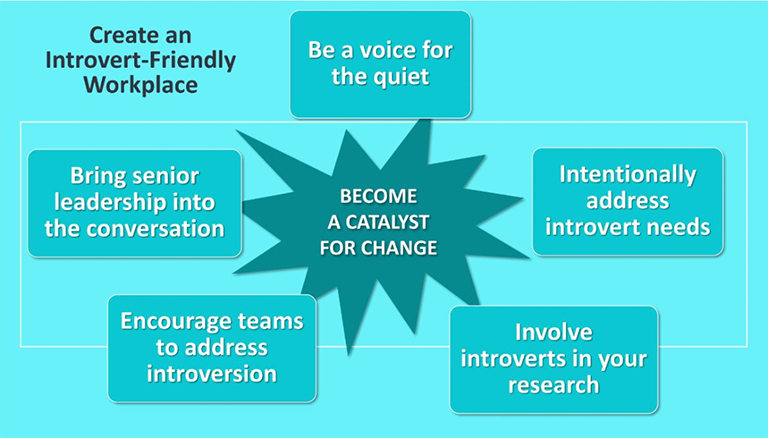“So how do we create introvert-friendly workplaces during the quarantine?“ “How does all this apply to the new world of work? ” These questions, or ones like them, come up in most of the interviews about my new book, Creating Introvert-Friendly Workplaces. And my answer is that the ideas are especially relevant now. In fact, if we are to keep talent engaged and continuing to perform in challenging times of economic and social unrest, there is even more urgency to adopt these practices.
I do hope that we can look at this time as an opportunity to make overdue workplace changes. Being an exemplary leader of introverts, focusing on non-biased hiring and promotion practices, creating high-performance remote work situations and flexible office spaces are all ways to let everyone know they matter.
Seven Key Areas To Address
In the book, I highlight seven key functions that organizations should address to create more introvert-inclusive cultures and work practices. Let’s take a look at each of them and how they are especially relevant now in creating introvert-friendly workplaces during quarantine:
- Bringing on great introvert talent – In 2019, we did a workplace survey of 240 professionals, mostly introverts. A promising 38 percent of respondents said their organizations demonstrated a willingness to hire and promote introverts. And now, you can take advantage of our increasing comfort with virtual technologies.Offer people the chance to see what it is like to work for your company through well thought out branding on company YouTube channels. Also, video interviews can be used to establish deeper conversations with potential hires without the pressure of on-site interview stressors.
- Leading introverts – Leaders now need to take extra time to connect with all of their employees. They should listen to learn what the challenges are and where they can offer support. One sales leader realized that none of the introverts were sharing on his weekly global conference calls. “I decided to wait for at least 5 comments to be made before I spoke up. It was hard, but so worth it because we heard many new voices.”
There are multiple opportunities in this time out of the office to focus on expanding your knowledge about unconscious bias. Without even realizing it, you may see introverts as slow, indecisive, anti-social, and unhappy. This could be impacting the kinds of opportunities and support you are giving them.
- Communicating with introverts – In the work from home scenario, it is easy to become disconnected. Leaders need to provide safe environments where people can share. Employee Resource Groups (ERG’s) like those established at 84.51° are forums where introverts can meet around specific topics. These groups sponsor discussions where people openly talk and understand each other in new ways. We have had recent large, global turnouts at Kimberly Clark’s Asia Pacific ERG , for example, on introverted leadership.Another consideration is to talk with introverts on your teams about their preferred ways of interacting. How can we all relieve the stress of unexpected interactions, both in and out of the office? Interruptions are very disturbing to introverts.
- Designing workplace settings – Organizations have learned a lot about being flexible in the past few months. For many, there has been a huge positive response to remote work. But what about for those companies going back to the office or for those who never left?If designed to function well, an open office plan can be just as effective as a traditional private one. Built-in quiet pods, where the conversation is off-limits, can provide places to focus. Lack of privacy and noise were perennial complaints from introverts we researched pre-COVID. Now, as you consider re-entry or hybrid plans of work, ask introverts what they think and listen to their ideas for addressing these potential problems in the office.
- Remote work – Working from home can offer increased autonomy and distraction-free solo time introverts require to do their best work. However, that isn’t true for everyone, including parents with children and other family members who are home. More companies are offering options from paid leave to childcare assistance in order to help working parents.
Organizations are customizing their work at home and in-office combinations. Zillow’s Chief People Officer, Dan Spaulding recently said, “…we also recognize that there is a balance between where people can be most effective, and that balance is unique for all of us. For some people, that may mean coming into the office a couple of days every month, and other people may want to come into the office three or four days a week just because of how their situation sets up.”Don’t assume because people are introverted they automatically want to work at home. Not all do. Remote work can go a long way in creating introvert-friendly workplaces during quarantine, but it’s not for everyone and may not be as we move forward.
- Building teams – Teams should be made up of diverse members and allow for all to contribute, not just the loudest voices. A positive side of virtual meetings are they are offering opportunities to engage introverts by opening up smaller break out rooms and one on one conversations. These platforms are also allowing us to hear from diverse global voices as, geography is not an issue. Astute team leaders realize they need to give introverts much needed solo time to prepare before meetings, so they feel solid about their contributions. They also understand that allowing introverts time to work alone maybe not only preferred but necessary to achieve idea breakthroughs (ex. shower thoughts, anyone?)
- Enhancing learning and development – As organizations work to keep their employees up to speed they are using online training programs from the increasing number of methodologies and platforms out there. Learning at their own pace and in their own time suits the introvert temperament well.
There are many creative ways to involve introverts in virtual deliveries that include written chat functions, having a pre-session Q &A, and giving plenty of time for both solitary reflection and small group discussions. Be sure to take advantage of all of these tools as they fit your needs.
Many introverts will not miss classroom training. However, someday we may come back to the live classroom and there are lots of ways to make that introvert-friendly too (see chapter 8 in the book).
Anyone can be a change agent
If you agree that there is room in your company to harness introvert talent, then I encourage you to step up and become a catalyst for change. Start by taking the Creating An Introvert-Friendly Workplace quiz and compare your responses to others in your organization. See what is currently working and where there is room for improvement.
Be a voice for the quiet. Encourage others to address introversion and bring senior leadership into the conversation. You can be a change agent and transform your company into one where everyone feels like they belong during quarantine and after.





